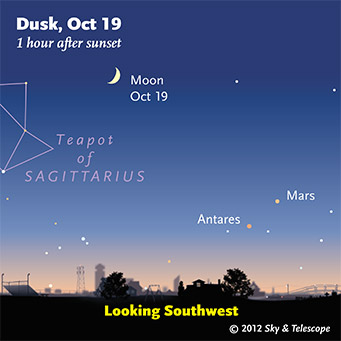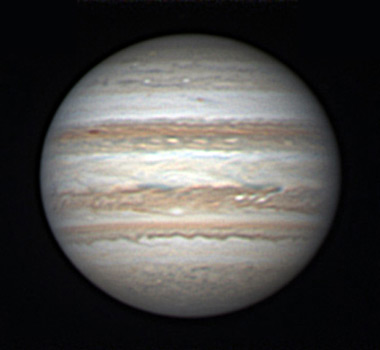
The 4-day-old Moon is obvious, Mars and Antares much less so.
Sky & Telescope diagram
Friday, October 19
For all of Jupiter's satellite events and Great Red Spot transits this month, good worldwide, see "Action at Jupiter" in the October Sky & Telescope, page 52.
Saturday, October 20
Sunday, October 21
Monday, October 22
Tuesday, October 23
Wednesday, October 24
Thursday, October 25
Friday, October 26
Saturday, October 27
Want to become a better amateur astronomer? Learn your way around the constellations. They're the key to locating everything fainter and deeper to hunt with binoculars or a telescope.
For an easy-to-use constellation guide covering the whole evening sky, use the big monthly map in the center of each issue of Sky & Telescope, the essential guide to astronomy. Or download our free Getting Started in Astronomy booklet (which only has bimonthly maps).

The Pocket Sky Atlas plots 30,796 stars to magnitude 7.6 — which may sound like a lot, but that's less than one star in an entire telescopic field of view, on average. By comparison, Sky Atlas 2000.0 plots 81,312 stars to magnitude 8.5, typically one or two stars per telescopic field. Both atlases include many hundreds of deep-sky targets — galaxies, star clusters, and nebulae — to hunt among the stars.
Sky & Telescope
Once you get a telescope, to put it to good use you'll need a detailed, large-scale sky atlas (set of charts). The standards are the little Pocket Sky Atlas, which shows stars to magnitude 7.6; the larger and deeper Sky Atlas 2000.0 (stars to magnitude 8.5); and the even larger Uranometria 2000.0 (stars to magnitude 9.75). And read how to use sky charts with a telescope effectively.
You'll also want a good deep-sky guidebook, such as Sue French's Deep-Sky Wonders collection (which includes its own charts), Sky Atlas 2000.0 Companion by Strong and Sinnott, the bigger Night Sky Observer's Guide by Kepple and Sanner, or the classic if dated Burnham's Celestial Handbook.
Can a computerized telescope replace charts? Not for beginners, I don't think, and certainly not on mounts and tripods that are less than top-quality mechanically (able to point with better than 0.2° repeatability). As Terence Dickinson and Alan Dyer say in their invaluable Backyard Astronomer's Guide, "A full appreciation of the universe cannot come without developing the skills to find things in the sky and understanding how the sky works. This knowledge comes only by spending time under the stars with star maps in hand."
This Week's Planet Roundup

Jupiter on October 23rd, showing its side away from the Great Red Spot. Below center, the North Tropical Zone has turned fully white again to separate the tan North Equatorial Belt (NEB) from the narrower North Temperate Belt (NTB) below it. Note the dark, sharp, scalloped northern rim of the NTB, and the row of three bright white outbreaks in the NEB. Jim Phillips in South Carolina used a 10-inch Maksutov scope to take this stacked-video image at 5:31 UT. South is up.
Jim Phillips
Mercury (magnitude –0.2) is having a poor evening apparition. Using binoculars, look for it 20 or 30 minutes after sundown very low in the southwest, to the lower right of Mars and Antares.
Venus (magnitude –4.0, at the Leo-Virgo border) rises in darkness more than an hour before the first glimmer of dawn. By dawn it's shining brightly in the east.
Mars (magnitude +1.2, in Ophiuchus) is still low in the southwest in evening twilight. It's more or less above similar-looking Antares. The two are about 4° or 5° apart.
Jupiter (magnitude –2.7, in Taurus) rises in the east-northeast around 8 or 9 p.m. daylight saving time. Once it's clear of the horizon, look for fainter orange Aldebaran to its right and Beta Tauri (Elnath) a little farther to its left. By dawn this lineup-of-three stands high and vertical in the west.
Saturn is hidden behind the glare of the Sun.
Uranus (magnitude 5.7, at the Pisces-Cetus border) and Neptune (magnitude 7.9, in Aquarius) are in in good view in the southeast to south during evening. Finder charts for Uranus and Neptune.
All descriptions that relate to your horizon — including the words up, down, right, and left — are written for the world's mid-northern latitudes. Descriptions that also depend on longitude (mainly Moon positions) are for North America. Eastern Daylight Time (EDT) equals Universal Time (also known as UT, UTC, or GMT) minus 4 hours.
Like This Week's Sky at a Glance? Watch our weekly SkyWeek TV short. It's also playing on PBS!
To be sure to get the current Sky at a Glance, bookmark this URL:
http://SkyandTelescope.com/observing/ataglance?1=1
If pictures fail to load, refresh the page. If they still fail to load, change the 1 at the end of the URL to any other character and try again.
 0
0
Comments
You must be logged in to post a comment.